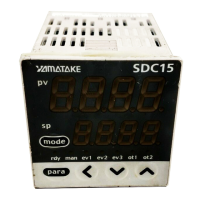
Do you have a question about the Azbil C15 and is the answer not in the manual?
| Type | Digital indicating controller |
|---|---|
| Input Type | Thermocouple, RTD, DC voltage, DC current |
| Size | 1/16 DIN |
| Control Mode | PID control |
| Output Type | Relay, voltage pulse |
| Number of Control Outputs | 1 or 2 |
| Display | LED |
| Power Supply | 100 to 240 VAC, 50/60 Hz or 24 VAC/VDC |
| Dimensions | 48 x 48 x 78 mm |
General safety guidelines and warnings for product usage.
Unit applications and features.
Function outlines and operation flow.
Installation details and conditions.
Wiring procedures and precautions.
Setup for initial operation.
Settings during operation.
PID tuning functions.
Maintenance and fault resolution.
Technical specifications.
Unit features and design.
Table for choosing unit models.
Identification of unit parts.
Description of main components.
How inputs and outputs are configured.
General operation using unit keys.
Critical warnings related to wiring and electrical safety.
Caution on self-tuning function.
Alarm codes and fixes.
